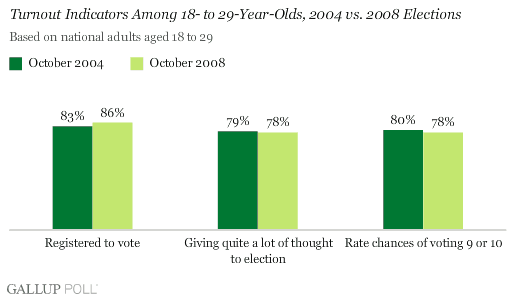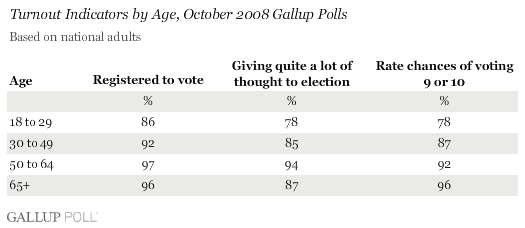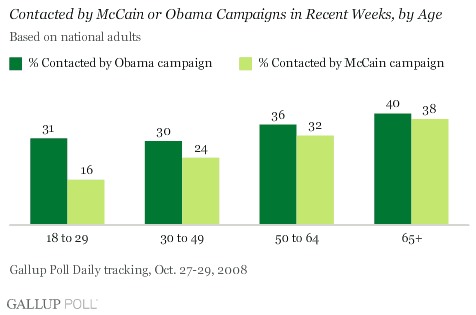PRINCETON, NJ -- Gallup polling in October finds little evidence of a surge in young voter turnout beyond what it was in 2004. While young voter registration may be up slightly over 2004, the reported level of interest in the election and intention to vote among those under 30 are no higher than they were that year.

What's more, 18- to 29-year-olds continue to lag behind Americans aged 30 and older on these important turnout indicators.

As a result, 18- to 29-year-olds now constitute 12% of Gallup's traditional likely voter sample, basically the same as the estimate in the final 2004 pre-election poll (13%). Gallup's expanded likely voter model, which defines likely voters differently (on the basis of current voting intentions only), estimates a slightly higher proportion of young voters in the electorate (14%). However, even if the share of the youth vote were adjusted upward, doing so has little or no impact on the overall Obama-McCain horse-race numbers using either likely voter model.
It is possible that the 18- to 29-year-old share of the likely voter electorate will grow in the final days of the election. Although interest in the election and voting intentions usually increase as Election Day grows nearer, Gallup did not observe much of an increase from mid- to late October 2004, because interest was already at high levels (as it is this year).
A second possibility for heightened youth turnout would be voter mobilization efforts. Such efforts can convince people with little motivation or interest in the campaign to actually vote on Election Day. Gallup has been measuring voter contact in its daily tracking poll this week in an effort to gain a better understanding of this important component of the "ground game" in the final days of the campaign.
As of Oct. 27-29 polling, 39% of 18- to 29-year-olds had been contacted by either the Obama or McCain campaigns. That is the same contact rate seen among 30- to 49-year-olds, but is well below that of Americans 50 and older. So thus far, in a general sense, mobilization efforts have not reached the young voters to the same extent that they have older voters.

The overall contact rates by age hide a significant disparity in contact by the two campaigns. Americans under 30 are about twice as likely to report having been contacted by the Obama campaign as by the McCain campaign. Thirty-one percent of 18- to 29-year-olds have been contacted by the Obama campaign, compared to just 16% who say the McCain campaign has contacted them.
The rate of Obama campaign contact of young adults compared to those who are older is similar, ranging from 31% among younger Americans to 40% for those 65 and older. On the other hand, there is a much larger age skew in reported contact by the McCain campaign, ranging from just 16% for the younger group to 38% for those 65 and older.

The higher contact rates for Obama among the younger group reflect his greater level of support among this group than among the general population, a fact that has been well-documented. These contact levels for younger voters no doubt reflect that each candidate's campaign this year appears to be targeting its contact toward its known supporters -- reflecting the strategic decision that voter contact best serves to reinforce the base and get out the vote rather than to attempt to change voters' minds. Plus, given the historic fact that younger voters are less likely to turn out at the polls and vote, it may be that the Obama campaign sees a fertile opportunity among this group for increased votes.
The graph also makes clear that the Obama campaign has been more successful in reaching voters, regardless of their age.
Implications
While Gallup data do suggest that voter turnout among young people will be high this year (as it was in 2004) compared to historical turnout rates, the data do not suggest that it will be appreciably higher than in 2004. Even if more young voters are registered this year, they do not appear to be any more interested in the campaign or in voting in the election than they were in 2004.
Unless turnout rates among older age groups drop substantially from what they were in 2004, young voters should represent about the same share of the electorate as in the last presidential election. And Gallup's data suggest interest in the campaign and voting are the same or higher among older voters compared to what they were in 2004.
Gallup will continue to monitor campaign contact between now and the end of its pre-election polling, to see whether that could be a factor in promoting higher turnout among voters this year.
Survey Methods
Results are based on telephone interviews with 2,279 national adults, aged 18 and older, conducted Oct. 10-12 and Oct. 23-26, 2008. For results based on the total sample of national adults, one can say with 95% confidence that the maximum margin of sampling error is ±2 percentage points.
For results based on the sample of 237 18- to 29-year-olds, the maximum margin of sampling error is ±7 percentage points.
Interviews are conducted with respondents on land-line telephones (for respondents with a land-line telephone) and cellular phones (for respondents who are cell-phone only).
In addition to sampling error, question wording and practical difficulties in conducting surveys can introduce error or bias into the findings of public opinion polls.
